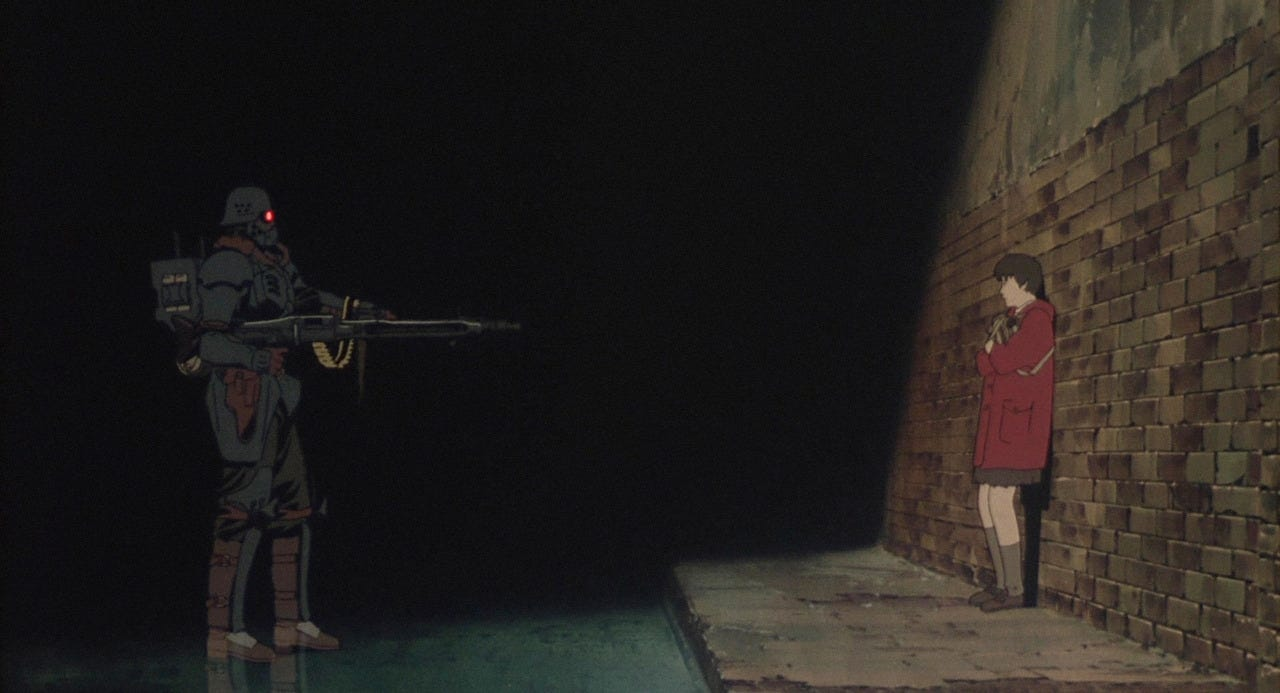Jin-Roh: The Wolf Brigade (1999) and the Increasing Militarization of Police

The subject of police officers is one of the most controversial topics in the U.S. right now. Police officers often get a bad reputation primarily for their abuse of power, specifically in their treatment of people of color. After the War in Iraq, many police departments experienced a surplus and have armed themselves as a private militia force. Politicians often think about what would happen if the police keep arming themselves for civil service. Written by Mamoru Oshii and directed by Hiroyuki Okiura, Jin-Roh: The Wolf Brigade addresses this very issue.
In an alternate version of history, Japan is bombed by Germany, who wins the Second World War. This leads to an increased militarization of the state police force in Japan, who act as the peacekeepers in society. Kazuki Fuse is a Constable in the elite Kerberos Panzer Corps, who deal with domestic counter-terrorism. One night, he is witnesses a young terrorist blow herself up. The incident traumatizes him and he is forced back into the police academy for re-education. While visiting the suicide bomber’s ashes, he meets her sister, Kei Amemiya, and the two become friends. Through meeting her, Kazuki is forced to confront his own humanity and questions his purpose in the Kerberos Panzer Corps.

Mamoru Oshii originally wanted to make Jin-Roh: The Wolf Brigade as a live-action feature like the previous two entries. It would conclude his Kerberos Saga franchise, a trilogy made of Jin Roh: The Wolf Brigade, the Lynchian mind fuck The Red Spectacles and Stray Dog: Kerberos Panzer Corps. However he was unable to do so due to scheduling conflicts with Ghost in the Shell. Oshii then decided to make it into a six episode OVA with Bandai Visual, but due to his scheduling conflicts, was unable to direct. Instead, he was given a screenplay credit and worked alongside Hiroyuki Okiura, who designed the characters in Ghost in the Shell, feeling that out of all of the staff at Bandai, Okiura was the person he trusted most with his work.
As its namesake suggests, Jin-Roh: The Wolf Brigade contains a lot of allegories to wolves. Wolves are seen in the museum where Kazuki and Kei meet at, with Kei comparing the police to wolves. The Kerberos Panzer Corps is a highly militarized police unit that civilians consider as predators among society, hunting down protestors and snuffing out any signs of insurrection. Additionally, the motif of “Little Red Riding Hood” appears frequently. Often quoted by Kei, the motif is a metaphor for the friendship between Kazuki and Kei. Later in one of Kazuki’s nightmares, he is chasing after Kei, who is wearing a red pea coat, in a sewer. As the chase continues, wolves come out of the pipes as Kei tells him he can’t follow her. The wolves then devour her and he sees himself shooting her in cold blood.

To complement its heavy storytelling, Jin-Roh: The Wolf Brigade has some of the most fluid animation not just of its time, but in anime history. Okiura hated using computer animation, and instead, drew everything by hand. The final product was breathtakingly natural and smooth character movements, unlike some anime today, which look too stiff. Additionally, the film pays incredible attention to detail. Every frame has an extraordinary amount of detail on the characters’ clothes, weapons, and even captures their breath. The film’s color palette also matches its darker and more somber themes, utilizing very desaturated shades of browns, reds, and gray.
Another element of the film that is done well is the sound. It sounds very raw, and lets you feel the world’s weight. The guns are to be particularly noted, always sounding like they hit hard, which considering that machine guns are used primarily, makes it even stronger. The sound is mixed well, with the dialogue being audible rather than overpowered by the music, and the background sounds are hearable without being grating. Composed by Hajime Mizoguchi, the score has a very somber tone that seamlessly combines elements of both soft jazz and melodic vocals.

Jin-Roh: The Wolf Brigade grossed about $95,000 worldwide and won several awards for Best Animation, mostly in Japan. In 2018, a South Korean remake was made, titled Illang: The Wolf Brigade. The remake follows an alternate reality where political order in South Korea is compromised which forces Japan to “remilitarize.” Both Koreas then reunite, which draws controversy from the U.S., Russia, and China. While Mamoru Oshii gave the film praise, the remake was bombarded with negative reviews, on top of being a box office bomb. Ouch.
Film is an artistic medium that while primarily acts as a form of entertainment, can also be used to explore political and social commentary on important issues. And while most may point to more well-known films such as Bong Joon-Ho’s Parasite, many don’t realize that animated films can do this just as well as their live action counterparts. And Jin-Roh: The Wolf Brigade is a perfect example of an animated film tackling the very real issue of the increasing militarization of the police and what that would potentially lead to.








